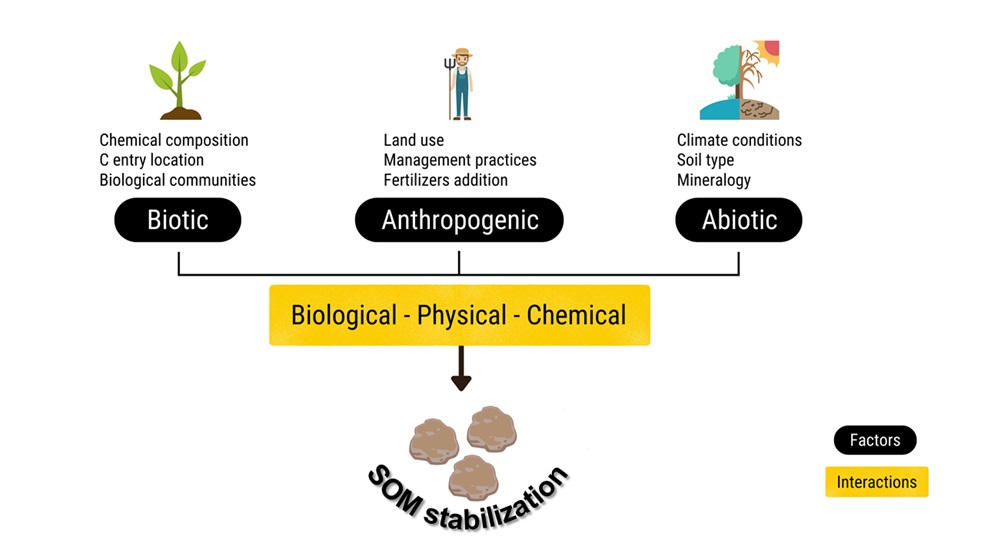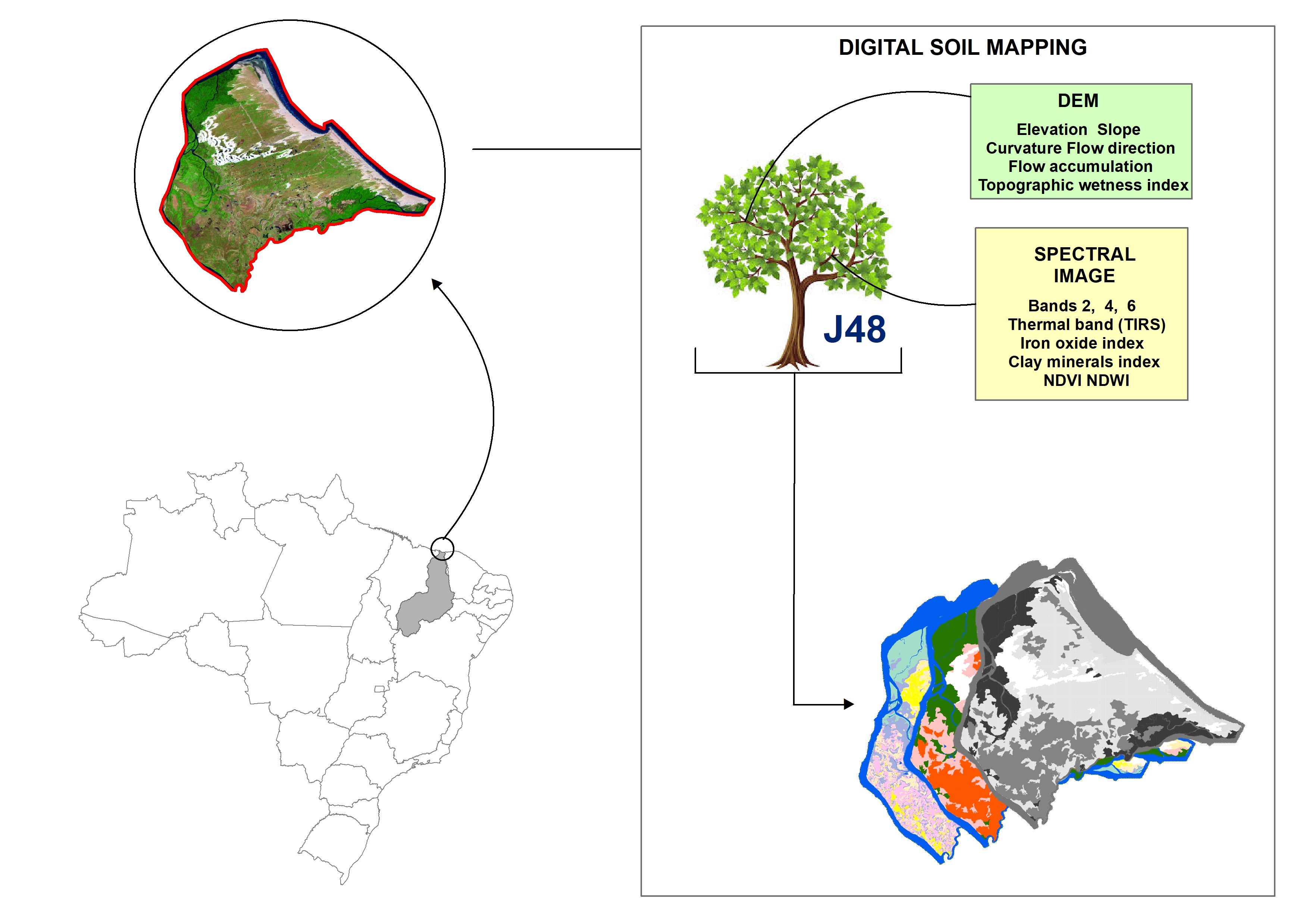Earthworms in the state of Paraná, Brazil: State of the art
06/Jun/2023
ABSTRACT Paraná State has approximately 74 % of its territory destined for agricultural activities. Several agricultural management practices modify soil quality and biodiversity, including earthworm populations that can contribute to soil health. This study aimed to review the studies carried out in the state of Paraná, Brazil, focusing on earthworm populations (abundance, biomass, richness, proportion of native and exotic species) in different land-use systems. In total, 51 publications were compiled, including peer-reviewed papers, book chapters, dissertations and theses. We used […]
Reflectance spectroscopy in the prediction of soil organic carbon associated with humic substances
06/Jun/2023
ABSTRACT Understanding organic carbon and predominant humic fractions in the soil allows contributes to soil quality management. Conventional fractionation techniques require time, excessive sampling, and high maintenance costs. In this study, predictive models for organic carbon in humic substances (HS) were evaluated using hyperspectral data as an alternative to chemical fractionation and quantification by wet digestion. Twenty-nine samples of Neossolos Flúvicos (Fluvents) – A1, and 36 samples of Cambissolos (Inceptisols) – A2 were used. The samples were also analyzed jointly, […]
Soil organic carbon fractions in agroforestry system in Brazil: seasonality and short-term dynamic assessment
23/May/2023
ABSTRACT Adopting land-uses that contribute with a considerable litter input can affect the accumulation, protection, and bioavailability of organic carbon in the edaphic environment, compromising the different compartments of soil organic matter (SOM) and the associated benefits. Moreover, changes in seasons can influence the dynamic of SOM. Notably, the mechanisms involved in SOM stabilization and storage, particularly in agroforestry production areas, are still poorly explored. This study aimed to verify if the contents of soil organic carbon (SOC) and the […]
Straw management effects on global warming potential and yield-scaled greenhouse gas emissions in a subtropical rice ecosystem
23/May/2023
ABSTRACT Global warming potential (GWP) of rice paddies depends on straw management. This study evaluated methane (CH4) and nitrous oxide (N2O) emissions and soil C stocks to determine GWP and yield-scaled GWP under different strategies and intensities of rice straw management in a subtropical climate. We hypothesized that decreasing soil management intensity and straw incorporation in the soil would reduce GWP. Methane fluxes were substantially higher during the rice growing season than in the off-season, while the opposite was observed […]
Soil carbon fractions in response to mineral and organic fertilizer types and rates
25/Apr/2023
ABSTRACT The use of organic fertilizers from pig slurry and poultry litter can increase soil organic carbon and crop productivity. This study aimed to evaluate soil organic carbon fractions and corn yield after applying organic and mineral fertilizers. The experiment was conducted in the western region of Santa Catarina State, southern Brazil on a Nitossolo Vermelho Eutroférrico típico (Rhodic Kandiudox). The production system was an integrated crop-livestock using corn and soybean in the summer and black oat and rye with […]
Soil properties changing and carbon losses by anthropic drainage in savanna palm swamp (vereda), central Brazil
24/Apr/2023
ABSTRACT In the Cerrado, the palm swamps ( veredas ) are characterized by being humid and stable environments that lead to the formation of Histosols ( Organossolos ). and soils with surface horizons of organic constitution, which are fragile and sensitive to anthropic action. This study aimed to evaluate the impact of anthropization (recurrent forest fires and livestock farming) on the chemical, physical and morphological properties of soils in two palm swamps in the Environmental Preservation Area (EPA) of Pandeiros […]
Stabilization of organic matter in soils: drivers, mechanisms, and analytical tools – a literature review
12/Apr/2023
ABSTRACT Soils are the largest terrestrial carbon (C) reservoir, and most of this C is retained as soil organic matter (SOM). Due to its ability to capture, stabilize, and store C for extended periods, soils are considered important allies in decarbonizing the atmosphere. The term ‘C stabilization’ includes a series of mechanisms or processes by which soil C is protected within soils and its losses are reduced through microbial decomposition or leaching. Due to their relevance in the global C […]
Mitigation of greenhouse gases emission affected by no-tillage and winter cover crops in a subtropical paddy rice ecosystem
06/Apr/2023
ABSTRACT Paddy rice production based on traditional soil management emits large amounts of methane (CH4) into the atmosphere. This study assessed the potential of no-tillage (NT) and winter cover crops (WCC) to mitigate net greenhouse gas (GHG) emissions in a subtropical paddy rice ecosystem. A long-term (20-yrs) experiment was evaluated regarding the effect of NT combined with winter fallow or three WCC (ryegrass, white oat, and birdsfoot trefoil) on seasonal CH4 -C and nitrous oxide (N2O-N) emissions and on soil […]
Soil nitrogen transformation and functional microbial abundance in an agricultural soil amended with biochar
04/Apr/2023
ABSTRACT Biochar soil amendments are attracting attention as one strategy to improve soil microbially ecological environment and regulate the soil nitrogen cycle. This study aimed to evaluate the effects of biochar application on agricultural soil improvement, nitrogen (N) mineralization and nitrification. The experiment was carried out on a typical farmland containing black soil and saline-alkaline soil in Northeast China. Four treatments were undertaken, including the control-treated black soil farmland (CS), the biochar-treated black soil farmland (BCS), the control-treated saline-alkali soil […]
Digital soil mapping for the Parnaíba River delta, Brazilian semiarid region
04/Apr/2023
ABSTRACT Soil mapping is a permanent demand, but the traditional method does not allow fast execution and low cost. Digital soil mapping (DSM) aims to improve the process by working with models that treat soil spatial variability quantitatively. In this perspective, the objective of the study is to perform DSM of the Parnaíba River Delta, Northeastern Brazil, through the decision tree (DT) integration technique using a set of attributes derived from the digital elevation model (DEM) and satellite images as […]



